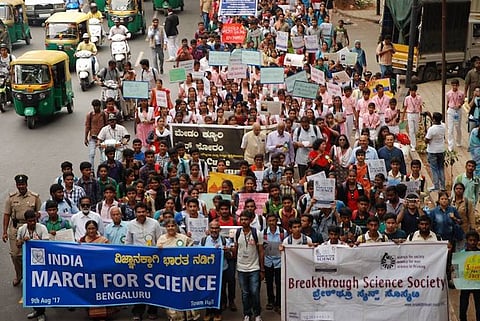

The Bengaluru chapter of the India March for Science held on Wednesday saw hundreds of people joining hands to promote science.
Organised by Breakthrough Science Society, the event saw a gathering of scientists, researchers, academicians, students and citizens alike.
In Bengaluru, the march began at Town Hall and ended at the Senate Hall where a group from the scientific community discussed the need for increased government funding in the science sector and enacting policies based on evidence-based science.
The March for Science is a global movement that "champions robustly funded and publicly communicated science as a pillar of human freedom and prosperity".
Similar marches were conducted in several other cities across India including Hyderabad, Thiruvananthapuram, Chennai, Mumbai and Bhubaneswar.
Among the other demands made by the India leg of the movement are stopping the propagation of "unscientific, obscurantist ideas and religious intolerance, and develop scientific temper, human values and spirit of enquiry in conformance with Article 51A of the Constitution".
Most members of the scientific community who spoke at the Senate Hall on Wednesday afternoon mentioned that apart from inculcating a scientific temper, we also need to work towards living in a society that is not superstitious.
Professor Dipankar Chatterji, Chairman, MBG, Jawaharlal Nehru Centre for Advanced Scientific Research, stated how even in this day and age, a lot of us, in villages and cities alike, continue to believe in superstitions.
"Just a few days ago," he said, "I watched on TV that two girls from a village in Bengal died of snake bites. They had been taken to an ojha (quack) instead of a doctor. Even today, many students who come to me for joining my laboratory wear stones on their fingers, one for mangaland, one for ravi and what not, or arms. My first question to them is why are they wearing it and they say their grandmother had given it to them, thus avoiding responsibility. Please tell people in your domain that what a terrible wastage of money this is."
Following the same line of thought, Professor DP Sengupta from Indian Institute of Science narrated a conversation he had with an ex-colleague, who was a professor of aerodynamics.
The two men used to go on morning walks and one day they got talking about a new kind of aeroplane which changed its geometry in flight.
Sengupta asked his colleague, "Don't you think this is a great invention?"
"What's so great in it? We had the same in India," he replied.
"What do you mean?" a surprised Sengupta asked.
"Pushpak Rath," he said.
"Are you referring to the Pushpak Rath that Ravana used to abduct Sita (in Ramayana)?" Sengupta futher questioned.
"Don't put it that way. We used to produce it in our country earlier," he stated.
"But how is that even after years of research and learning, we haven't been able to develop a light combat aircraft?"
"The technology is forgotten," the ex-colleague said matter-of-factly.
Addressing the audience, Sengupta added, "That's wrong. We cannot mix mythology with science. The greatest thing about science is that science moves forward and not backward."
Taking the discussion forward, Professor Sarbari Battacharya, Department of Physics, Bangalore University, stated that "Pushing the edge of the science forward works on the premise that we actually do not know the answer. And there's absolutely no shame in this ignorance. Accepting it and trying to find the answer is what is important rather than imagining that it has all been done before and that if it hasn't been done, it is not worth doing."
She also added that scientific development is necessary even though we may not be able to see its immediate translation to some kind of a technological utility.
"The first scientists who tried to investigate the bacteria that causes mastitis (inflammation of the mammary gland) in goats would never have thought these bacteria would perhaps form the base of artificial bacteria which someday, who knows, may produce bio-fuel or absorb carbon dioxide from the atmosphere and even generate vaccine," she said.
What the scores of students present also got to understand is that science is not limited to becoming a doctor or an engineer. One can be a geologist, or work in defence, take up microbiology and even explore space.
The march ended on a note that for a better tomorrow, we need to encourage young minds today.
As Professor TV Ramachandra from the IISc's Centre for Ecological Sciences put it, "If children inculcate scientific temper, they will grow up to be better decision makers tomorrow and that is what we need.”